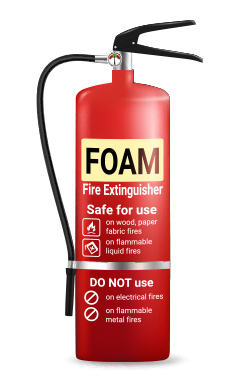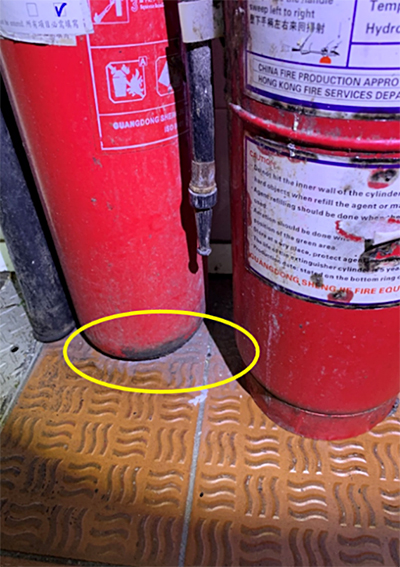Campus Health and Safety
Portable Fire Extinguishers


Portable fire extinguishers are able to control or extinguish small fires. The usefulness of portable fire extinguishers depends on whether people know how to use them. It is a good idea to make sure that Departmental Safety Officers and staff members in various departments/offices know what it is for, and when it is to be used.
Good practices for handling fire extinguishers in the workplace.
1. Proper Selection of Fire Extinguishers
Fire extinguishers are designed to tackle specific types of fire. In the University, the four most commonly used fire extinguishers are carbon dioxide, water, dry powder and foam.

Carbon Dioxide Gas Type Extinguisher
Use: On electrical fires, flammable liquids, electronic equipment or documents.
Notes: Vapours will asphyxiate. Withdraw to open air after use.

Water Type Extinguisher
Use: On fires involving wood, plastic, textiles or paper.
Never: On fires involving electrical or flammable liquids or metals.

Dry Powder Type Extinguisher
Use: On most fires, including flammable liquids or electrical fires.
Notes: Discharged dry powder may reduce visibility and cause disorientation.

Foam Type Extinguisher
Use: On fires involving flammable liquids.
Never: On electrical fires.
2. Proper Storage of Fire Extinguishers
- It is the duty of owners of fire extinguishers to ensure the proper storage of the fire extinguishers and keep them in proper working order.
- Location of fire extinguishers is critical. Make sure that Departmental Safety Officers and staff members in various departments/offices know the location of the fire extinguishers.
- Fire extinguishers should be placed in areas that are easily accessible and clearly visible. Always keep areas in front of fire extinguishers clean and clear of obstructions.
- Fire extinguishers need to be mounted at lower height with the carrying handle about 3 feet above the floor.
- Sign, pictogram or other means of identification should be available to indicate the location of the fire extinguisher.

3. Use of Fire Extinguishers - PASS
Pull: Point the nozzle away from you and pull the locking pin.
Aim: Aim the nozzle at the base of the fire.
Squeeze: Squeeze the lever slowly and evenly. If you release the lever, the discharge will stop.
Sweep: Sweep from side to side to cover all areas of the fire.
Staff and students are encouraged to attend hands-on training on the use of fire extinguishers. These courses are usually offered at the start of semesters.
4. Proper Maintenance and Disposal of Fire Extinguishers
Under Cap. 95B Fire Service (Installations and Equipment) Regulations - Duty of owners of fire service installations or equipment, the owner of any fire service installation or equipment which is installed in any premises shall:
(a) keep such fire service installation or equipment in efficient working order at all times; and
(b) have such fire service installation or equipment inspected by a registered contractor at least once in every 12 months.
In addition, the fire extinguishers shall undergo a hydraulic pressure test every five years to ensure that such fire service installations are always in good standby conditions. Source: Fire Services Department
Under the following conditions, we should first contact CMO for follow-up action:
- There are signs of damage or corrosion.
- After an extinguisher has been used, even if it is only partially used up, it must be recharged according to the manufacturer’s instructions.
- Unserviceable fire extinguishers should be disposed properly. Improper disposal of fire extinguishers will not only pose risks to the public, but also result in prosecution.


